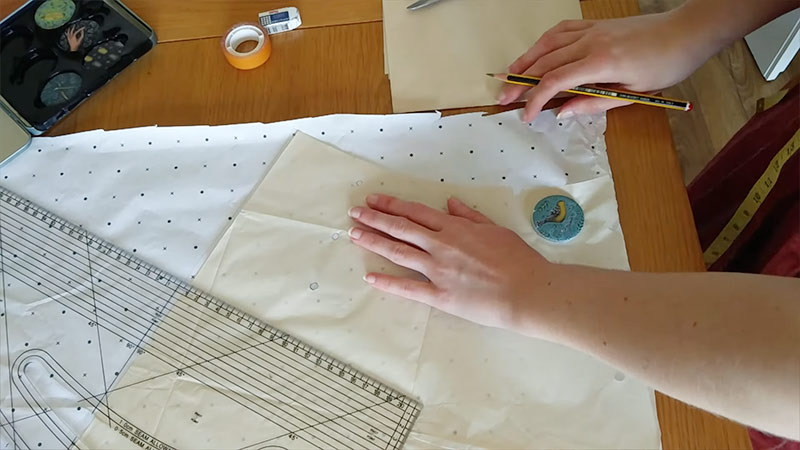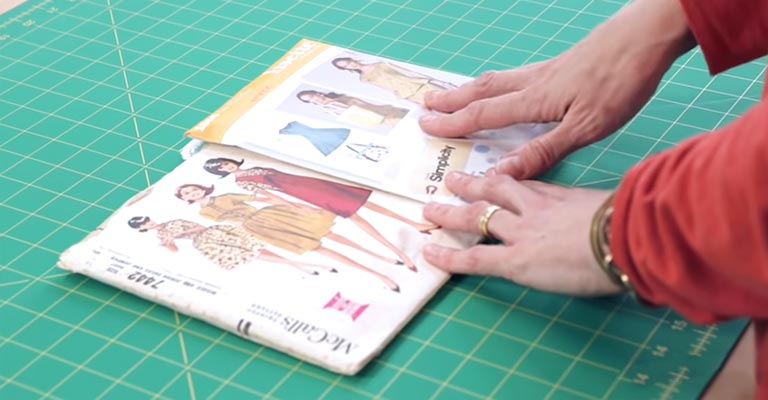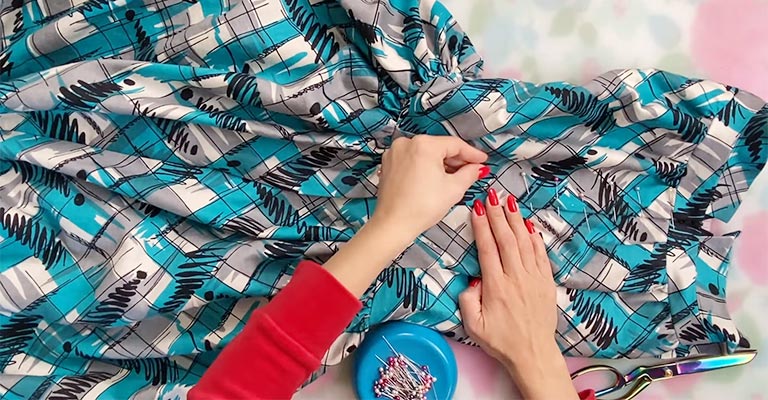Sewing patterns are not just templates for creating garments; they are windows to the past, offering glimpses into the ever-evolving world of fashion. “What Makes A Sewing Pattern Vintage” explores the intriguing qualities that transform a pattern into a vintage treasure.
Vintage sewing patterns transcend time, bearing the hallmarks of a bygone era’s style, construction techniques, and cultural influences.
This article delves into the age, design elements, packaging, and historical significance that render these patterns unique and cherished by collectors, enthusiasts, and seamstresses alike.
Discover how these patterns, rooted in history, continue to inspire and captivate the world of sewing and fashion.

What Makes A Sewing Pattern Vintage?
Sewing patterns have a unique way of capturing the essence of their time, reflecting the fashion trends, tastes, and crafting techniques of the era in which they were created.
A sewing pattern is considered vintage when it possesses certain key characteristics and qualities that set it apart from contemporary patterns.
Here’s a closer look at what makes a sewing pattern vintage:
Age
The most fundamental criterion for a sewing pattern to be deemed vintage is its age. While there’s no universal consensus, a pattern is typically considered vintage if it’s at least 20 years old.
However, the definition can vary among collectors and enthusiasts, with some preferring to designate patterns as vintage after 25, 30, or even 50 years. The passage of time adds historical and nostalgic value to these patterns.
Historical Era
Vintage sewing patterns are indelibly linked to the historical periods in which they were produced. They encapsulate the distinctive fashions and styles of their time, providing a window into the past.
For instance, patterns from the 1920s may feature flapper dresses, those from the 1950s emphasize swing skirts and patterns from the 1970s showcase bell bottoms.
Unique Design Elements
Vintage sewing patterns often boast design elements that were emblematic of their era. These could include specific silhouettes, neckline styles, sleeve shapes, or intricate embellishments that were in vogue during the period.
Vintage patterns carry the essence of the time’s fashion sensibilities.
Out-of-Production
Vintage sewing patterns are no longer in production. Many have been discontinued by the original pattern companies, making them relatively scarce in contemporary markets. This scarcity contributes to their desirability among collectors.
Packaging and Presentation
The packaging and presentation of vintage patterns can be strikingly different from modern counterparts. Vintage patterns may feature unique graphic design elements, vintage artwork, and printing techniques that were typical of their time. The packaging itself can be a collector’s item.
Collectibility
Some sewing enthusiasts and collectors highly value vintage patterns as collectible items. The rarity, condition, and historical significance of these patterns can significantly impact their collectibility and, in turn, their vintage status.
Collectors seek out these patterns for their historical and aesthetic value.
Cultural Significance
Vintage sewing patterns often carry cultural and historical significance, reflecting not only clothing styles but also the societal norms, values, and aspirations of the time in which they were produced.
They provide a lens through which one can explore the broader cultural context.
Historical Events
Patterns influenced by or created in response to significant historical events, such as wars or economic changes, can hold a special place among vintage patterns. They become tangible reminders of the challenges and adaptations of their time.
Designer Patterns
Sewing patterns associated with renowned fashion designers or design houses can be highly sought after and considered vintage due to their connection with influential figures in the fashion industry.
Construction Techniques
Vintage sewing patterns may incorporate construction techniques and methods that have evolved or become less common in contemporary patterns. These techniques are a distinctive feature that sets them apart.
What Are Some Unique Design Elements in Vintage Sewing Patterns?

Vintage sewing patterns often feature unique design elements that are characteristic of their respective eras. Here are some examples of design elements commonly found in vintage sewing patterns:
Silhouette
The overall shape and silhouette of garments in vintage patterns can vary significantly from one era to another. For instance, the 1920s featured loose, drop-waist silhouettes, while the 1950s favored hourglass shapes with nipped-in waists.
Understanding the silhouette can instantly identify the era of a vintage pattern.
Neckline Styles
The neckline styles in vintage patterns can be distinctive. Examples include the high, ruffled collars of the Victorian era, the bateau (boat) necklines of the 1960s, or the off-the-shoulder styles of the 1980s. Necklines play a crucial role in the overall design.
Sleeve Shapes
The shape and length of sleeves can vary widely between eras. Vintage patterns may feature puffed sleeves, bell sleeves, cap sleeves, or even no sleeves, depending on the fashion trends of the time.
Embellishments
Vintage sewing patterns often include unique embellishments, such as lace, embroidery, appliqué, or fabric manipulation techniques like smocking, pintucks, or ruching. These decorative elements add charm and character to the garment.
Prints and Fabrics
The choice of prints and fabrics in vintage patterns can reveal a lot about the era. For instance, the 1960s embraced bold, psychedelic prints, while the 1940s often featured practical, utilitarian fabrics due to wartime rationing.
Button and Closure Styles
The type and placement of buttons and closures on vintage garments can be a defining design element. For example, the use of large decorative buttons or unique closure styles like metal zippers from the 1930s can be telltale signs of vintage design.
Hem Length
The length of a garment’s hemline is a key design element that changes with fashion trends. Mini skirts of the 1960s, midi skirts of the 1970s, and maxi dresses of the 1970s are just a few examples of how hem length can be an iconic feature.
Collar Styles
The collar style can vary greatly in vintage patterns, from the large, pointed lapels of the 1970s to the delicate Peter Pan collars popular in the 1950s.
Pocket Designs
The design and placement of pockets on vintage garments can be unique. For example, the use of patch pockets, welt pockets, or decorative pockets can all contribute to the overall design.
Seam Details
Vintage patterns may incorporate distinctive seam details, such as princess seams, darts, or godets, to achieve a particular fit or design element.
What Construction Techniques Are Unique to Vintage Sewing Patterns?

Vintage sewing patterns often feature construction techniques that were commonly used during their respective eras. These techniques can differ from contemporary sewing methods and add unique character to vintage garments.
Here are some construction techniques that are often associated with vintage sewing patterns:
Hand Sewing
Before the advent of modern sewing machines, hand sewing was the primary method of constructing garments. Vintage patterns may include instructions for hand-sewn seams, hems, and closures.
Tailoring Techniques
Vintage patterns for tailored garments, like suits and coats, often include traditional tailoring methods. This can involve pad-stitching, canvas interfacing, and other techniques to achieve structured and fitted results.
French Seams
Vintage patterns may instruct sewists to use French seams, which encase raw fabric edges for a clean and polished look. This technique is often found in vintage lingerie and delicate garments.
Bound Buttonholes
Vintage patterns, especially for coats and jackets, may feature bound buttonholes. These are hand-finished buttonholes with fabric bindings, adding durability and an elegant touch.
Smocking
Smocking is a decorative technique commonly used in vintage patterns for children’s clothing and blouses. It involves gathering and stitching fabric in a decorative pattern, creating a textured and stretchy design.
Pintucks
Pintucks are narrow, parallel rows of stitching that are commonly found in vintage patterns for blouses, dresses, and children’s clothing. They create a delicate and decorative texture.
Hand Embroidery
Vintage patterns for heirloom or embellished garments often include hand embroidery instructions for decorative stitching, monograms, or intricate designs.
Gathers and Ruffles
Vintage patterns may use gathered fabric or ruffles extensively, especially in dresses, skirts, and sleeves. These techniques add volume and feminine details to garments.
Invisible Zipper Application
While invisible zippers are not unique to vintage patterns, they were widely used in the mid-20th century. Vintage patterns often include instructions for inserting invisible zippers, which create a seamless closure.
Use of Snap Fasteners and Hooks
Vintage patterns may recommend using snap fasteners and hooks for closures, especially in lingerie, undergarments, and accessories. These methods were more common before modern zipper technology.
Mitered Corners
Mitered corners are precise, angled seams often used in vintage patterns for napkins, tablecloths, and linens. They create neat and professional-looking corners.
Boning and Cording
Vintage patterns for corsets, bustiers, and structured bodices may incorporate boning and cording to create shaping and support.
Set-in Sleeves
Set-in sleeves, where the sleeve is sewn into an armhole with a curved seam, are a classic technique found in vintage patterns. They provide a tailored fit and shape.
Bias Binding
Bias binding is used to finish edges and create a neat, durable edge finish. Vintage patterns may include instructions for making and applying bias tape.
FAQs
Are there specific design elements that make a sewing pattern vintage?
Yes, vintage sewing patterns often feature unique design elements like era-specific silhouettes, neckline styles, and sleeve shapes that define their vintage character.
What are the most iconic eras for vintage sewing patterns?
Iconic eras for vintage sewing patterns include the 1920s flapper style, the 1950s hourglass silhouette, and the 1970s bell bottoms, each with its own unique charm.
What are the key factors that make vintage sewing patterns desirable?
The desirability of vintage sewing patterns stems from their historical significance, design elements, cultural context, and the appeal of creating fashion pieces with a touch of nostalgia.
How can I preserve and care for vintage sewing patterns?
To preserve vintage patterns, store them in acid-free containers, protect them from moisture and sunlight, and handle them with care to prevent damage.
Where can I find and purchase vintage sewing patterns?
You can find vintage sewing patterns at thrift stores, antique shops, online marketplaces, and from fellow collectors. Some websites specialize in selling vintage patterns.
To Recap
The world of vintage sewing patterns offers a captivating journey through time, where fabric and thread become windows into history.
The ageless charm of vintage patterns, with their distinct design elements, construction techniques, and cultural context, continues to inspire creativity and evoke nostalgia.
Whether you are a collector seeking rare finds or a passionate seamstress connecting with the past, these patterns hold a unique allure. They remind us that fashion is a reflection of the times, and vintage sewing patterns preserve those moments beautifully.
So, as you delve into the world of vintage patterns, remember that every stitch is a stitch in time, linking the past with the present, and sewing a unique and enduring connection between generations.
Leave a Reply